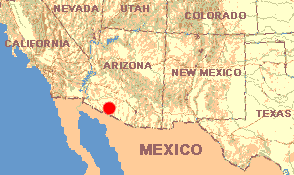 March 11,
1988
March 11,
1988ARIZONA: Pima County
In desert off AZ Hwy. 85 about ten miles SE of Ajo, just north of the entrance to Organ Pipe Cactus National Monument
 March 11,
1988
March 11,
1988![]() ITEM: A
DARKLING BEETLE, ELEODES
sp.
ITEM: A
DARKLING BEETLE, ELEODES
sp.
At dusk a couple of nights back while I lay in Henry, something began moving
across the sand below the window. In the darkness it could have been anything from a mouse
to a tarantula. The flashlight revealed a very sturdily built, completely black beetle
over an inch long. Walking stiffly on long legs armored with jagged serrations, it kept
its ample rear-end elevated high above its head. Having never seen this species before and
not knowing whether it might bite, I nudged it with a stick. It reacted by bowing its head
to the sand and poking its rear-end even higher. This was done with such purposefulness
that I half expected the business end of a switchblade to flip out. However, nothing
visible happened. Only when I picked up the fascist-looking beetle did I finally
understand its defense. Issuing from the rear end was the intense odor of super-bitter
Creosote-bush. If I'd been a raccoon exploring this bug with my nose, I'd have been
stymied. The field guides refer to this insect as a kind of darkling beetle, sometimes
called stink beetle, or Pinacate beetle. It's in the genus Eleodes. About 100 Eleodes
species occur in the Western States. I'm betting that this one eats creosote-bush sometime
during its life cycle.
![]() ITEM: NO AGAVES, NO YUCCAS
ITEM: NO AGAVES, NO YUCCAS
Since arriving in the Sonoran Desert, agaves and yuccas -- so characteristic of
the Chihuahuan Desert -- have practically disappeared. Leg-stabbing lechuguillas haven't
been seen since western Texas. As agaves and yuccas gave the Chihuahuan its special
flavor, here two species of giant cactus do the same. About one species, the Saguaro, we've already rhapsodized enough. The second
species is the Organpipe Cactus, Cereus thurberi, which
here grows to around 15 feet tall. These two species of giant cactus are easy to
differentiate. Saguaros form a single, massive stem that branches sparingly about midway
up, while organpipes branch profusely from their bases. Each Organpipe stem is much
smaller in diameter than the Saguaro's single stem.
![]() ITEM: COYOTE CALLS
ITEM: COYOTE CALLS
Any coyote-expert would recognize many diverse coyote call-types. I've been able
to identify two. One is the familiar, drawn-out call heard in cowboy movies, and which
school kids make when they see a full moon: Auoooooooooooo.... The second is
harder to describe. If about eight half-drunk, teen-aged boys decided to "let it all
hang out" by dancing in circles around a campfire while yelping, and if as they
yelped they couldn't quite decide what kind of sound would be proper, and if they
possessed absolutely no sense of rhythm, harmony or civility, then they'd be approximating
this second kind of coyote call.